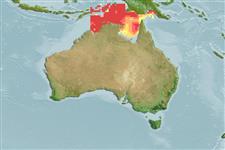>
Carangaria/misc (Various families in series Carangaria) >
Polynemidae (Threadfins)
Etymology: Polydactylus: Greek, poly = a lot of + greek, daktylos = finger (Ref. 45335).
Environment: milieu / climate zone / depth range / distribution range
Écologie
marin; saumâtre démersal. Tropical; 6°S - 17°S, 127°E - 147°E (Ref. 57343)
Western Pacific: Papua New Guinea, Australia, and the Arafura Sea.
Taille / Poids / Âge
Maturity: Lm ? range ? - ? cm
Max length : 20.0 cm TL mâle / non sexé; (Ref. 3132)
Body uniformly golden-silver. Pectoral fin rays unbranched, blackish; tip of uppermost filament reaching to or just short of level of posterior tip of upper part of pectoral fin (Ref. 41110).
Collected off river mouths as well as offshore (Ref. 57343). Inhabits coastal waters over sand or mud bottoms (Ref. 3132). Known to be taken at 150 m in the Gulf of Carpentaria but typically from a much shallower depth (Ref. 3132).
Life cycle and mating behavior
Maturities | Reproduction | Spawnings | Egg(s) | Fecundities | Larves
Motomura, H., 2004. Threadfins of the world (Family Polynemidae). An annotated and illustrated catalogue of polynemid species known to date. FAO Spec. Cat. Fish. Purp. Rome: FAO. 3:117 p. (Ref. 57343)
Statut dans la liste rouge de l'IUCN (Ref. 130435)
Menace pour l'homme
Harmless
Utilisations par l'homme
Pêcheries: sans intérêt
Outils
Articles particuliers
Télécharger en XML
Sources Internet
Estimates based on models
Preferred temperature (Ref.
123201): 26.7 - 28.2, mean 27.8 °C (based on 106 cells).
Phylogenetic diversity index (Ref.
82804): PD
50 = 0.5000 [Uniqueness, from 0.5 = low to 2.0 = high].
Bayesian length-weight: a=0.01738 (0.00751 - 0.04023), b=3.05 (2.86 - 3.24), in cm total length, based on LWR estimates for this (Sub)family-body shape (Ref.
93245).
Niveau trophique (Ref.
69278): 3.5 ±0.5 se; based on size and trophs of closest relatives
Résilience (Ref.
120179): Haut, temps minimum de doublement de population inférieur à 15 mois (Preliminary K or Fecundity.).
Fishing Vulnerability (Ref.
59153): Low vulnerability (10 of 100).
